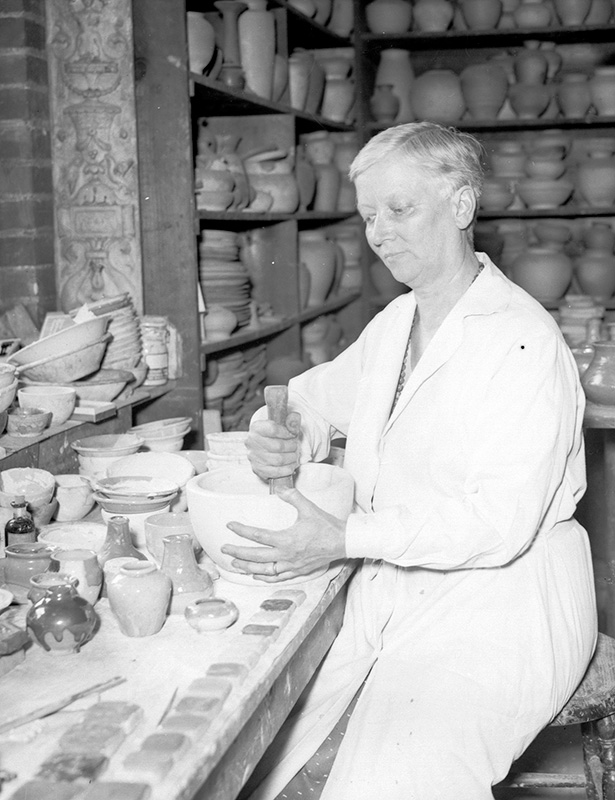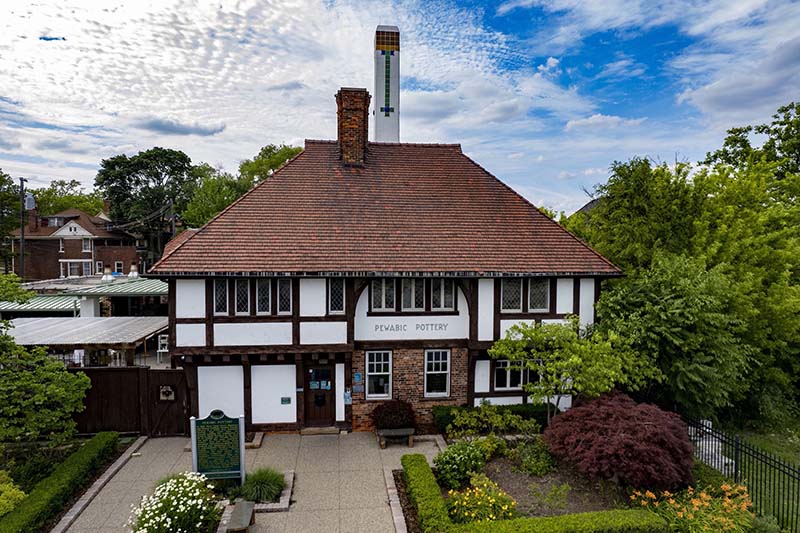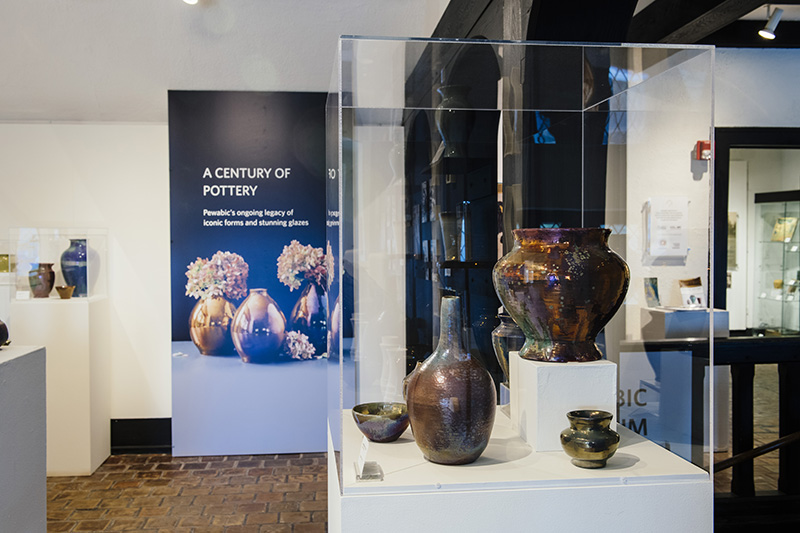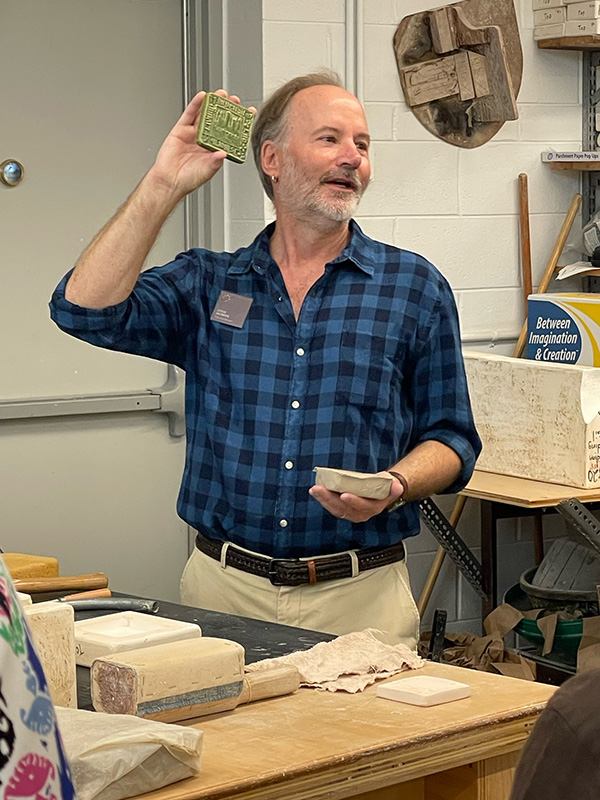Handcrafted Brilliance: Detroit’s Pewabic Pottery
Click on images to enlarge them and view captions.
by Andrew Lunney
During the Trust’s summer Sojourn to Michigan’s Motor City, our intrepid travelers studied an architectural, collecting, and design legacy rooted in Modernism. Detroit, founded as an early-18th-century French trading post, boomed between 1850 and 1950, welcoming a large swath of European immigrants seeking economic opportunity and African Americans fleeing the Jim Crow South. With the advent of industrialist Henry Ford’s automobile assembly line, the region soared to extraordinary economic heights as the global automotive capital. Inaugurating an era of innovation, Detroit’s downtown development of both revival-inspired and cutting-edge buildings signified this Midwestern hub as a 20th-century design destination.
Our cohort sampled much of downtown’s grand urban development, from the stunning Art Deco Guardian Building skyscraper to the piered white marble and glass Minoru Yamasaki-designed Michigan Gas Company Building. Our Sojourn sampled another site, and artistic movement, developed in response to and alongside these modern impulses. As stone, steel, and glass gave rise to a soaring downtown, a burgeoning emphasis on handicraft was emerging. Native Michigander and ceramicist Mary Chase Perry (figure 1) established Pewabic Pottery in 1901 and became a regional and national leader in Detroit’s turn-of-the-century Arts and Crafts Movement. As technological advances accelerated Detroit’s business boom, Mary’s partnership with kiln manufacturer, dental supplier, and Pewabic co-founder Horace Caulkins transformed the way artistic tools could serve their makers. Mary and Horace formed a life-long business partnership that prioritized artistic skill and natural materials.
Located on the city’s then eastern boundary, Pewabic Pottery operated out of an English-styled inn designed by William Buck Stratton in 1906 (figure 2). Now a National Historic Landmark, which houses the still-operating pottery, the Tudor Revival, timber frame headquarters was a marked departure from Detroit’s downtown development. The design was ideal to house a small craft industry, and both Mary Chase Perry and William Stratton would respectively remain area leaders of the cultural community and eventually wedded in 1918. In her pottery, Named after a copper mine in her native Upper Peninsula, Pewabic focused on functional decorative arts and architectural accents.
Together, Mary and Horace developed a new kiln that fired pottery at radically high temperatures, allowing the studio to experiment with a variety of clay glazes. The result was Pewabic’s shimmering, iridescent glazed tiles and vessels, a luminous line-up of blush, matte green, copper, and aurora finishes (figure 3). The team experimented for years with metal oxides and atmospheric firings before perfecting their product, its unusual iridescence quickly coming into high demand and catapulting Pewabic as a ceramics leader and its signature stamp synonymous with the local Arts and Crafts Movement. For these trailblazing ceramics pursuits, Mary would earn honorary degrees from both Wayne State University and the University of Michigan, the latter presented in 1965 in recognition of its ceramics education program. Mary Stratton oversaw production at the studio until her death in 1961 at the age of 94.
After days filled with Mid-Century design pursuits, our Sojourn’s final morning began with an exclusive visit to the pottery. Pewabic’s Executive Director and practicing potter Steve McBride (figure 4) led the group through the pottery’s museum and production spaces. We could not help but notice his kind and proud grin boasting how the pottery’s production process was sustained over 100 years. In fact, the pottery still operates the c. 1912 clay mixer used by Mary, the same equipment that produced the clay for tilework found in downtown’s Guardian Building and Detroit Institute of Art, both of which the group visited previously. Steve concluded our tour in the pottery’s shop, with now mesmerized Trust travelers eagerly scouting out mementos.
The Pewabic Society, a nonprofit organization, assumed management of the pottery in 1981, and today continues Mary’s work, albeit with modifications in production. Although Mary’s brilliant tilework included glazes containing lead and even uranium, Pewabic products now gleam with safer elements to achieve the appearance of earlier work. The pottery continues the tradition of fabricating heirloom quality architectural tiles for public and private installations, vessels, gardenware, and seasonal ornaments. With a mission of enriching the human experience through clay, Mary Chase Perry Stratton’s initial ambition to elevate artistic objects still resonates a century later. Our digital era continues to romanticize and prioritize craftsmanship as Pewabic celebrates an unrivaled legacy of, and finds inherent purpose within, handcrafted brilliance.
Andrew Lunney is the former Educational Programs Assistant at the Decorative Arts Trust.
A print version of this article was published in The Magazine of the Decorative Arts Trust, one of our most popular member benefits. Join today!




